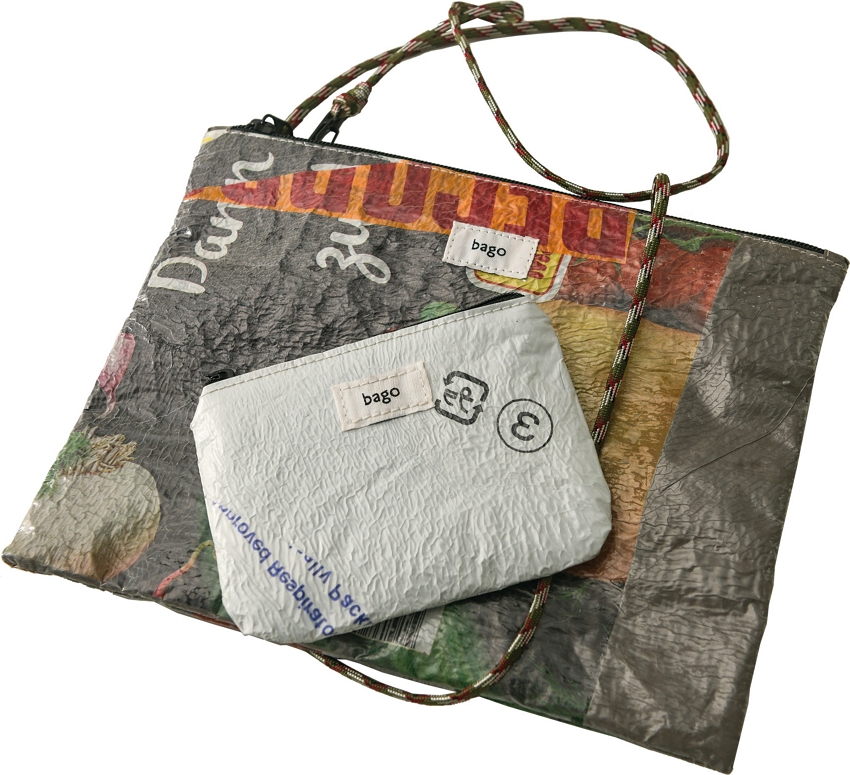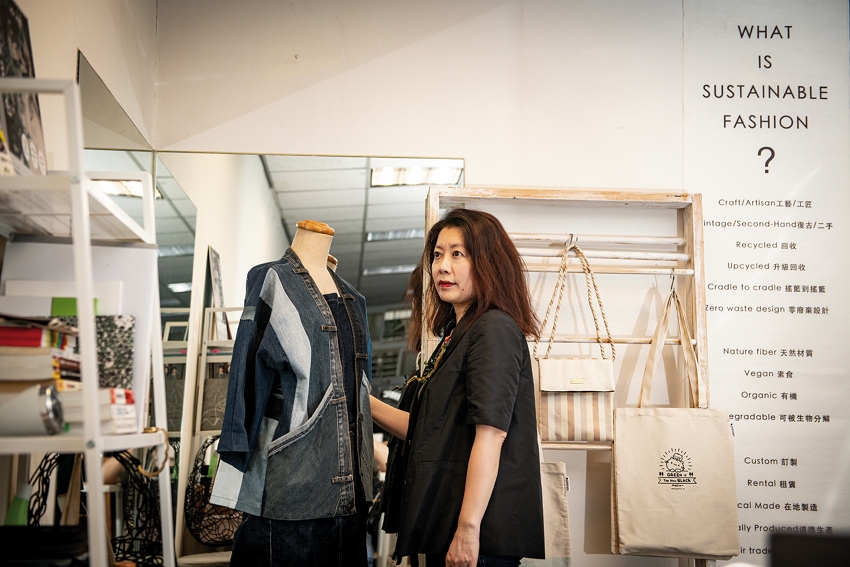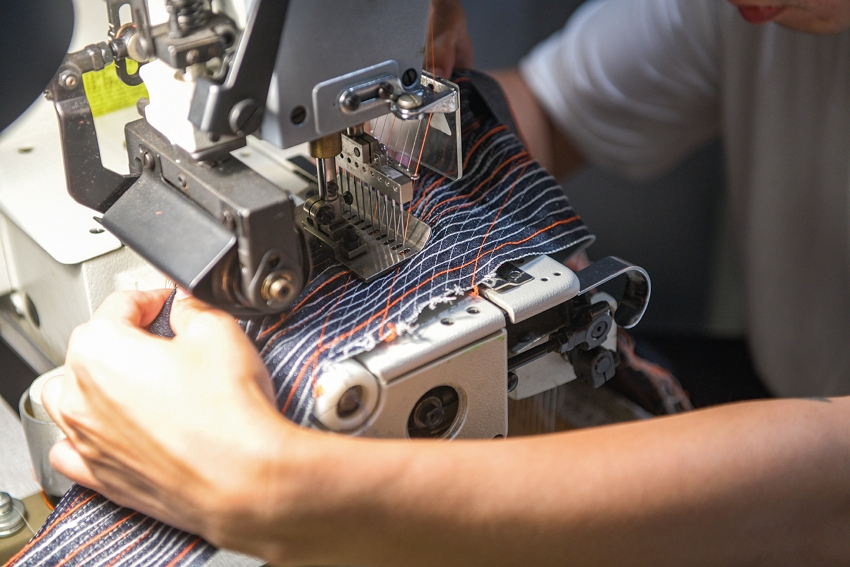
“Sustainable fashion” movement is encouraging us to apply long-term environmental thinking to our pursuit of beauty. (photo by Chuang Kung-ju)
You’ve probably seen clothing recycling bins on street corners. They’re everywhere, often overflowing with clothes. Though most people forget about them the minute they pass, the bins highlight an important issue.
The world produces more than 100 billion items of clothing per annum. With the old ever more rapidly making way for the new, Taiwan alone throws away more than 200 million garments every year.
This hard fact has given rise to a “sustainable fashion” movement that is encouraging us to apply long-term environmental thinking to our pursuit of beauty.
Old and new coexist on the streets of Taipei’s Dadaocheng neighborhood, an important hub for clothing designers. Today, we’re on the second floor of one of its many old buildings.
Jean Chang, the founder of fashion and design media platform picupi, welcomes us into her office. She tells us that Justin Chou and Apu Jan have studios nearby, and explains that she hasn’t had a chance to have air conditioning installed because she just moved into the space. While most people would find the muggy summer heat unbearable with only a fan to keep cool, Chang, who pursues a low-carbon lifestyle, says it isn’t too bad. “We all practice what we preach,” she says with a smile.
Chang recently left her career in mainstream fashion media, and in 2018 founded Taiwan’s first online media platform promoting sustainable fashion. A designer by training, Chang has worked in both fashion design and fashion media, first as a reporter and eventually as an editor-in-chief. In those roles, she promoted the consumption of luxury goods. Nowadays, people often call her an environmentalist. What caused her to change direction?

Sustainable fashion’s methods include reusing waste materials. This handbag and purse are made from recycled plastic bags that were heated and reshaped.
More and more, and then?
We move to a nearby cafe to begin the interview. Adamant about not using straws, Chang sips her iced drink straight from the glass, and says: “The fashion industry has changed completely over the last decade or so.”
Chang was first drawn to the industry by the allure of pretty things. But over the last decade, fashion’s rising output and falling prices have led to new clothes being thrown away after just one season. She says the contrast between the industry’s current state and that of her youth, when she had to work hard to acquire items and consequently treasured them, led her to deconstruct the cultural values she’d once believed in.
Chang’s goal in starting her own business was simple—she loved the industry and wanted to find ways to make it better. She says, “Capitalism’s self-serving pursuit of endless consumption won’t do so. The key is finding a balance between fashion and environmentalism.”
But even though calls for sustainability in fashion have been reverberating around the world for several years, the fashion industry has yet to take them to heart. Unable to find the kind of work she wanted, Chang decided to strike out on her own, and founded a media business to spread her ideas.

Jean Chang left her job in the mainstream fashion media when her ideas about beauty underwent a sea change.
Seeking new approaches
When some of Chang’s friends couldn’t grasp why she would leave the mainstream fashion media to become an advocate for the environment, and joked that she was reverting to a primitive life, she resolutely explained that sustainable fashion wasn’t what they imagined.
The United Nations’ Sustainable Development Goals, which are the spiritual antecedents to sustainable fashion, include eliminating hunger and poverty, and implementing sustainable models of production and consumption, as well as sustainably managing and using lands, forests, and the oceans. The ideas cover a lot of ground, and though they leave many questions about how they might be implemented, they have already given rise to a few projects.

Repurposing waste materials puts designers’ aesthetics to the test. Fashion designer Justin Chou used recycled denim to create this eyecatching image.
For a time, Chang ran a pop-up store in a 6.6 square meter space at the Songshan Cultural and Creative Park in Taipei. The store exhibited and sold products from 27 Taiwanese brands that promote sustainability. One of those she selected was Studio Lim, a young, Golden Pin Design Award winning brand that excels at playing with materials in interesting ways. Among its creations are plates made from waste materials that are as light as disposable plates, but also durable and washable. Studio Lim produces the plates by using heat and pressure to mold flax and scrap wood, and then painting the results with environmentally friendly paint. Patterned like marble, they make an eyecatching addition to the dining table.
Sustainable fashion’s integration of technology, focus on materials R&D, and use of design to resolve problems doesn’t look primitive at all!

At a cloth bank set up by the Industrial Technology Research Institute in partnership with a Tainan-based nonprofit, out-of-date inventory from fabric makers is sorted and displayed for sale to the public. Customers can get help from a staffer to turn it into garments or other items.
New second-hand clothes
In 2016, British movie star Emma Watson attended the New York City Metropolitan Museum of Art’s famous Met Gala in an elegant black-and-white trouser‡gown hybrid designed by Calvin Klein. Made from organic silk, organic cotton, and recycled plastics, the gown was designed in separate pieces intended to be mixed and matched with other outfits, and worn again and again.
Remanufacturing is another recent fashion trend, one that seeks to satisfy the industry’s appetite for the new and different in a sustainable and environmentally friendly way.

The Eden Social Welfare Foundation has partnered with FHCCR’s cloth bank to turn waste fabrics into interactive books that help handicapped children practice routine tasks.
In one example of it, Chang suggested to the Carpenter’s House, a charitable organization, that it solicit donations of second-hand denim clothing from the public, disassemble the donated garments, and then use the resulting fabric to make items it has designed to be produced in a modular way.
Justin Chou, a designer known for deconstructing and reassembling garments, offers a line of products made similarly from waste fabrics at T Fashion, an experimental fashion hub located on the fourth floor of Taipei’s Yongle Market, the largest fabric distribution center in Taiwan. The space even uses recycled fabrics for some of its decor—the image of the Taipei skyline hanging on the wall was pieced together from recycled denim.
Rejuvenating waste fabrics
One of the world’s major fabric makers, Taiwan has reaped a bitter harvest from mass production.
When too much is produced, large inventories and large amounts of waste materials, scrap fabric, sample fabrics, out-of-date fabrics, and defective goods accumulate and ultimately end up being thrown away.
Following the principles of the circular economy, Taiwan has established “cloth banks” that find new uses for waste fabrics, collecting these discards and providing them for design applications.

Industrial Technology Research Institute expert Huang Fei-ping (left) and FHCCR CEO Yen Shih-hua (right) are seeking new uses for waste fabrics.
Working from the textiles hub of Tainan, the Industrial Technology Research Institute (ITRI) partnered with the Foundation of Historic City Conservation and Regeneration (FHCCR) and local companies to promote an online cloth bank integrating the virtual and real worlds. The platform connects consumers to these companies, most of which are major fabric makers for brands like Nike, Adidas, Victoria’s Secret and Burberry. In addition to being involved with the platform, the foundation has opened its own brick-and-mortar store selling waste fabrics to the general public.
Such fabrics have many uses. ITRI expert Huang Fei-ping paired up seven design teams with seven companies to develop themed rooms at The Place Tainan, a luxury hotel. Everest Textile provided Galaxy Reflective fabric that was combined with acrylic to create decorative art installations that produce a multicolored shimmer effect in the light of a camera flash. The designers also hung Liberty Tex’s lace from walls and pressed it into tabletops to create gorgeous patterns.
ITRI’s initiative isn’t the only one. The Kaulin Foundation, which was established by a leading industrial sewing machine maker, has access to large volumes of waste fabric created when its parent is testing products, and began using them in what it calls “Project ReSew’s.”
The basement of the foundation’s offices in Taipei’s Dazhi area feels like a secret underground base. Eight sewing machines stand side by side. In addition to a conventional sewing machine and an overlocker, it also holds less common types, including one with 12 needles, a belt loop machine, a three-needle machine, and an eyeleting machine.
There are baskets of waste fabric on the floor, and foundation CEO Iris Lin opens the door to a storage room to show us stacks of cardboard boxes containing still more waste fabric from fabric makers throughout Taiwan. Having spent the last several years connecting manufacturers and designers, the foundation has become a channel through which waste fabrics can be reborn.
Off to one side, two pieces of clothing hang on dressmaker’s mannequins. Fashion designer Joe Chan created them using waste fabric, and with the help of the foundation is preparing to send them to Las Vegas, where ten Taiwanese designers will be exhibiting together.

This kind of 12-needle sewing machine is usually used to stitch elastic. Here, a designer is using one to sew different stitches in a variety of colors to create a decorative pattern on clothing.
Using a machine provided by the foundation, Chan added decorative stitches to a striped shirt, applying his design sensibility to functional stitches to create unique textured patterns in different colored threads.
The long shirt can be worn as a smock or a one-piece dress, and is suitable for both men and women. Its fit is even adjustable.
Even though clothing manufactured from waste fabric accounts for only the tiniest sliver of the mainstream fashion market, “as long as one piece out of ten of a designer’s work is created with this concept in mind, it shows an awareness of the issue. That means we’re achieving our educational objective.” Which gives Lin something to cheer about.











